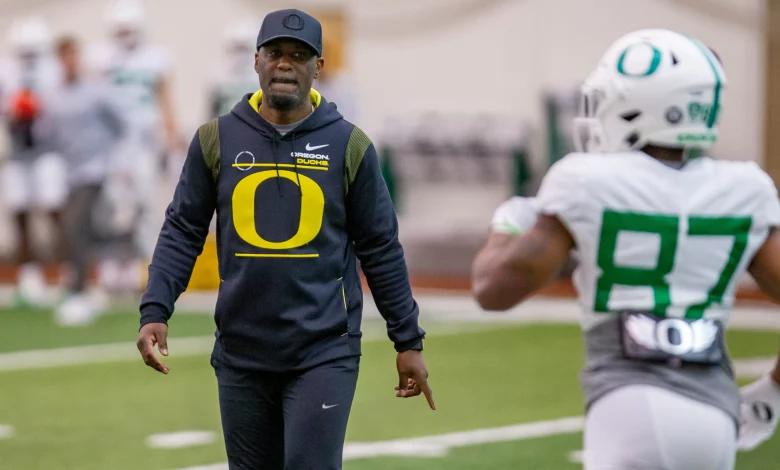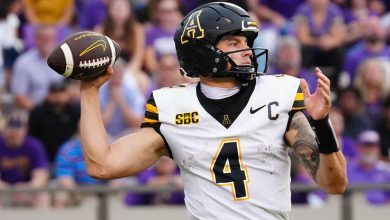Junior Adams, the wide receivers coach for the Oregon Ducks, is hired by the Dallas Cowboys.

In the fast-paced, ever-evolving world of college football, coaching changes are a regular occurrence, often bringing about a cascade of effects that can significantly impact both the teams involved and the broader football landscape. One of the latest moves making waves is the hiring of Junior Adams, the former wide receivers coach for the Oregon Ducks, by the Dallas Cowboys. This high-profile transition marks a key moment for both programs as Adams takes on a new challenge at the NFL level.
Adams, who had been with the Oregon Ducks for several years, established himself as one of the top wide receivers coaches in college football. His departure from Oregon comes at a time when the Ducks are looking to continue building on their successful football program, and his new position with the Cowboys represents a significant step in his career. With the Cowboys being one of the most storied franchises in NFL history, Adams now faces the daunting challenge of coaching a group of professional athletes at the highest level of competition.
This move is not only a notable development for Junior Adams but also raises important questions about the shifting dynamics of coaching and recruiting in both college and professional football. In this article, we will delve into the implications of Adams’ hiring, the impact on the Oregon Ducks, and what this means for the Dallas Cowboys as they look to further develop their receiving corps.
Junior Adams: A Look Back at His Career
Before his time with Oregon, Junior Adams had an extensive coaching career that spanned several programs. He began his coaching journey at the high school level before moving on to assistant coaching roles at various colleges, including stops at Western Kentucky and Washington. His ability to develop wide receivers and recruit top talent quickly became his signature, and Adams’ reputation as a rising star in the coaching world grew as he consistently produced high-performing wide receiver units.
At Oregon, Adams was tasked with coaching one of the most critical positions on the field: the wide receivers. His ability to recruit and develop talent was immediately apparent as he helped elevate the Ducks’ receiving corps to new heights. Players under his tutelage, including Jaylon Redd, Johnny Johnson III, and Dillon Mitchell, blossomed into some of the most dynamic playmakers in the Pac-12 conference.
Adams’ coaching style emphasized precision in route-running, mental toughness, and understanding the nuances of different coverages. He was known for pushing his players to not only develop the technical aspects of their game but also to adopt a mindset of resilience and confidence. His ability to adapt to the strengths of his players while also incorporating modern offensive concepts into Oregon’s system was one of the key factors behind his success.
Under Adams, the Ducks’ offense grew more dynamic, and the receiving corps became one of the team’s strongest units. The wide receivers played a key role in Oregon’s high-powered offense, and Adams’ leadership was integral in creating a culture of success. His ability to maximize the potential of each player and get the most out of the talent available to him made him an invaluable asset to the program.
The Hiring of Junior Adams by the Dallas Cowboys
When the Dallas Cowboys made the announcement that Junior Adams would be joining their coaching staff, it sent shockwaves through both the college football and NFL worlds. The Cowboys, who have long been one of the NFL’s most iconic franchises, are known for their strong emphasis on talent development and player coaching. Adams’ hire came at a time when the Cowboys were looking to strengthen their receiving corps and improve their passing game.
The Cowboys’ receiving unit, while talented, has often been inconsistent in recent seasons. While players like CeeDee Lamb and Michael Gallup have shown flashes of brilliance, the team has struggled at times to establish a reliable passing game. The addition of Adams, a coach with a proven track record of developing wide receivers, was seen as a move to address these issues and bring fresh energy to the position group.
In making this hire, Cowboys’ head coach Mike McCarthy and the team’s front office are betting on Adams’ ability to translate his success from the college game to the NFL. While the skillsets and dynamics of coaching college athletes and NFL professionals are different, Adams’ emphasis on developing fundamental skills, building relationships, and tailoring coaching to individual players’ needs will be assets in his new role.
For Adams, the opportunity to work at the highest level of football represents a significant step in his career. The NFL is a league that demands the best of the best, and the chance to work with elite players in a high-stakes environment will provide Adams with a unique opportunity to further hone his coaching skills. Additionally, working with top-tier quarterbacks like Dak Prescott will allow him to take his coaching to the next level, as wide receivers in the NFL are often required to adjust to multiple styles of quarterback play.
The Impact on the Oregon Ducks
Adams’ departure from Oregon is a major loss for the Ducks, as they now must find a replacement to lead one of the program’s most important position groups. Under Adams, Oregon’s wide receivers were among the best in the Pac-12, consistently making big plays and contributing significantly to the team’s offensive success. Losing a coach of Adams’ caliber presents a challenge for Oregon, as they now face the task of continuing the development of their wide receiver unit without one of the top coaches in the country.
Oregon’s offensive system has traditionally emphasized a balanced attack, with a focus on both the running game and passing game. Adams’ ability to develop a group of dynamic receivers was critical to maintaining that balance. The Ducks’ offense will likely have to adjust to a new coach, and while they have a strong recruiting pipeline and talented players on the roster, there is no guarantee that the next wide receivers coach will have the same level of success.
Recruiting will be another area where Adams’ departure will be felt. He had established strong relationships with high school recruits and was instrumental in bringing some of the best talent to Oregon. The Ducks will need to quickly identify a replacement who can continue to build on the foundation Adams left behind and maintain Oregon’s recruiting prowess.
Additionally, Adams was known for his ability to relate to his players and foster a positive team culture. His leadership helped create an environment in which wide receivers could thrive both on and off the field. Finding a replacement who can replicate this culture will be critical for Oregon’s continued success, especially in a conference like the Pac-12, which has become increasingly competitive in recent years.
What This Means for the Dallas Cowboys’ Receiving Corps
The arrival of Junior Adams in Dallas is expected to have a significant impact on the Cowboys’ receiving corps. While Adams has experience coaching college players, the NFL is a different level of competition, and he will now be tasked with working with established, high-profile players who are already at the peak of their athletic abilities. The Cowboys’ wide receivers, led by the talented CeeDee Lamb, will be looking to take their games to the next level under Adams’ tutelage.
One of Adams’ strengths as a coach has been his ability to adapt his coaching methods to the individual needs of his players. In Dallas, he will have the opportunity to work with players who have different strengths and skillsets. For instance, Lamb is known for his route running and ability to make big plays, while Gallup has demonstrated his ability to make contested catches. Working with players like these will require Adams to further refine his coaching techniques and tailor his approach to maximize their potential.
The Cowboys’ offense, led by Dak Prescott, has the pieces to be one of the most potent units in the NFL. However, consistency has been a challenge at times. Adams’ ability to develop chemistry between Prescott and his receivers, as well as his emphasis on precision route running and mental toughness, could prove to be the difference-maker for the Cowboys. By improving the overall efficiency of the passing game, Adams could help the Cowboys make a deep playoff run and potentially compete for a Super Bowl title.
Another area where Adams’ impact could be felt is in the development of younger players on the Cowboys’ roster. The team has a number of talented young wide receivers, and Adams’ ability to develop players at all levels could help these players reach their full potential. Whether it’s through improving their technical skills or teaching them how to approach the game mentally, Adams’ coaching expertise could help elevate the entire unit.
The Broader Implications for the NFL and College Football
The hiring of Junior Adams by the Dallas Cowboys represents an interesting crossroads between the worlds of college and professional football. As the NFL continues to look for fresh talent to develop its players, hiring coaches from the college ranks has become more common. College coaches are often known for their ability to connect with younger players, and their success in developing talent has made them attractive candidates for NFL positions.
For the Oregon Ducks, Adams’ departure serves as a reminder of the fluid nature of coaching in college football. Programs must always be prepared for the possibility of losing key staff members to higher-level opportunities. For the Cowboys, this hire demonstrates their commitment to developing their roster and improving the passing game.
Ultimately, the success of this hire will be judged by the performance of the Cowboys’ wide receivers under Adams’ coaching. If Adams can bring out the best in players like CeeDee Lamb, Michael Gallup, and others, the Cowboys could see significant improvement in their passing game, making them a more dangerous offensive force in the NFL.









